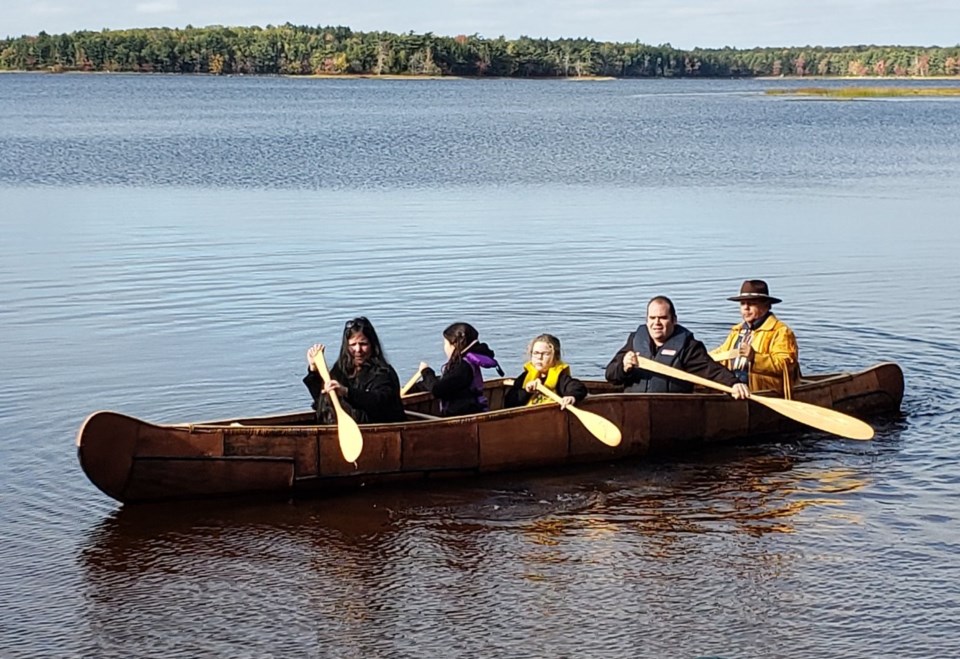The birch bark canoe was once the principal means of transportation for First Nations people, but over the years it has become somewhat of a lost entity.
However, master builder Todd Labrador is doing his best to keep the tradition alive, by continuing to build canoes the traditional way and sharing the stories of the Mi’kmaq people.
Labrador launched his latest birch bark canoe project, a 21.5-foot ocean, rough-water canoe – his largest to date - October 13, following a brief ceremony at Merrymakedge Beach. The beach is part of Kejimkujik National Park where Labrador constructed the canoe over the summer.
The ceremony featured Labrador and his grandson, Tepkunaset, smudging the canoe, while his daughter, Melissa Labrador, read a prayer. Tepkunaset and his sister, Nakuset, were also drumming during the ceremony. The event was not open to the public, but by invitation only due to COVID-19 restrictions.
“It was a grand day in Keji. The sun was shining, there was no wind and the lake was like glass,” reported Sophie Borcoman, visitor experience manager for Parks Canada at Keji. “It’s always a very happy and emotional experience. There is something very encouraging and beautiful about watching this tradition continue.”
The launch also coincided with October being Mi’kmaq History Month.
Labrador grew up on the Wildcat Reserve in Queens County, and has been building canoes at a facility in Kejimkujik Park for several years. He said the park is where numerous generations of his ancestors originated; building canoes in Keji means a lot to him.
“My great grandfather built canoes, there were many different relatives in our family that did. Because there is nobody building traditional Mi’kmaq canoes anymore, it is very important to do this, and to bring it back, and to share the stories, and involve as many people as we can,” he said.
Labrador said he appreciated Parks Canada, and especially Keji’s site manager, Jonathan Sheppard, “for giving me this opportunity and making things work.”
He learned about canoe building from his father, Charlie Labrador, late Chief of the Acadia Mi’kmaq First Nation, who in turn learned from his grandfather, Joe Jermey. Labrador’s father was not a canoe builder himself, but shared numerous stories of how his father had built them.
“That’s how I became interested in canoe building. And back in the mid-1980s I started playing around with model birch bark canoes,” explained Labrador.
He constructed his first in 1984 , which was approximately two feet long. Over the years, he made about a dozen model canoes. In 2004, he built his first, 14-foot canoe, which one could sit in and paddle.
This year’s canoe marks the 16th full-size canoe that Labrador has built. Working with Parks Canada, he has constructed eight canoes at Keji. His first, which is on display at the park’s visitor centre, was built in 2009. He constructed one in each of 2014 and 2015. In 2018 and 2019, he built two canoes both years. Last summer ‘s canoes were a 21-foot and 19-foot.
He plans to continue to build canoes and has his sights set on creating a 34-foot canoe one day.
Meanwhile, Labrador said he will continue to paddle this latest canoe until someone reaches out to him and wants to buy it for personal reasons or to make it a part of a community, heritage centre or museum.
He explained that building a birch bark canoe is a long journey and begins by stripping birch bark off trees and gathering spruce roots. Luckily, he’s had a lot of support in the task.
“I try to convince people to come and help and tell them digging spruce roots out in the forest is fun. They show up one day thinking that it will be fun. On the second day you won’t see them at all,” he said. “But no, I’ve had a lot of help from my daughter, grandkids, wife, friends and just from visitors that come by. I also have a lot of First Nations people stop by and give it a try. We have help from all over.”
This latest canoe used more than 1,000 feet of spruce root to lash the parts together.
According to Borcoman, Labrador has built up a loyal following over the years, with people showing up for different stages of the canoe building process.
“People often think they are going to drop by for a few minutes to see what is going on, or they are not quite sure what is happening. They end up staying for a much longer time than they intended. They get riveted by the whole process. It is quite extraordinary,” said Borcoman.



